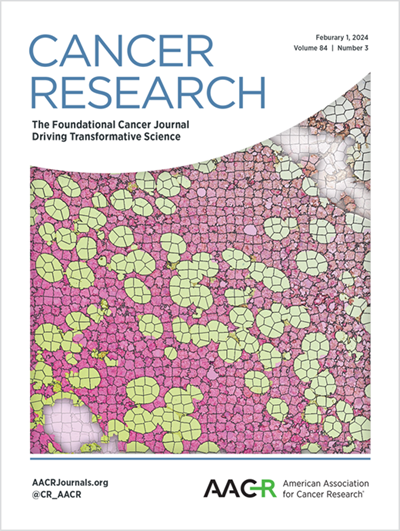Single Cell Analyses Reveal a Functionally Heterogeneous Exhausted CD8+ T Cell Subpopulation that is Correlated with Response to Checkpoint Therapy in Melanoma
IF 12.5
1区 医学
Q1 ONCOLOGY
引用次数: 0
Abstract
PD-1 pathway inhibitors have revolutionized cancer therapy. However, most patients do not durably benefit, highlighting the need for biomarkers to stratify patients as responders or non-responders. While CD8+ tumor infiltrating lymphocytes (TILs) have been associated with immune checkpoint therapy response, there is not a consensus on which CD8+ TIL subpopulations have the most prognostic value. Preclinical studies have focused on progenitor-like exhausted CD8+ T cells (TPEX), since TPEX proliferate more in response to PD-1 inhibitors than other exhausted T cell (TEX) subpopulations. However, immune checkpoint inhibitor (ICI) treatment drives TPEX differentiation into other TEX populations that can mediate anti-tumor immunity. These data complicate the ability to identify prognostically important T cell populations in patients that predict ICI treatment response. In this study, we found that advanced melanoma patients with ≥20% of CD8+ TILs co-expressing PD-1 and CTLA-4 (termed CPHi TILs) had better objective response rates and survival following PD-1 monotherapy than those below this threshold. Characterization of the CPHi TIL subset using bulk and single cell RNA sequencing showed that while TPEX-like cells were present within the CPHi subset, they were in the minority of these cells. Rather, the CPHi population was numerically dominated by other subsets, including cycling, terminally exhausted, cytotoxic-like, and/or resident memory-like TEX populations, and a subset enriched for glycolytic genes. Collectively, these data show that CPHi TILs correlate with response in melanoma, but this TIL subset is a heterogenous mix of different subpopulations that may differentially contribute to anti-tumor immunity following checkpoint blockade.单细胞分析揭示了与黑色素瘤检查点疗法反应相关的功能异质性耗竭型 CD8+ T 细胞亚群
PD-1 通路抑制剂给癌症治疗带来了革命性的变化。然而,大多数患者并不能持久获益,这就凸显了对生物标志物的需求,以便将患者分层为应答者或无应答者。虽然 CD8+ 肿瘤浸润淋巴细胞(TILs)与免疫检查点疗法的反应有关,但对于哪些 CD8+ TIL 亚群最具预后价值尚未达成共识。临床前研究主要关注祖细胞样衰竭 CD8+ T 细胞(TPEX),因为 TPEX 对 PD-1 抑制剂的增殖反应比其他衰竭 T 细胞(TEX)亚群更强。然而,免疫检查点抑制剂(ICI)治疗可促使TPEX分化为其他TEX亚群,从而介导抗肿瘤免疫。这些数据使得在患者中识别预后重要的 T 细胞群以预测 ICI 治疗反应的能力变得更加复杂。在这项研究中,我们发现,CD8+ TILs 共表达 PD-1 和 CTLA-4 的比例≥20%(称为 CPHi TILs)的晚期黑色素瘤患者接受 PD-1 单药治疗后的客观反应率和生存率均优于低于这一阈值的患者。使用大量和单细胞RNA测序对CPHi TIL亚群进行的表征显示,虽然CPHi亚群中存在TPEX样细胞,但它们只是这些细胞中的少数。相反,CPHi 群体在数量上以其他亚群为主,包括循环、终末衰竭、细胞毒性样和/或常驻记忆样 TEX 群体,以及一个富含糖酵解基因的亚群。总之,这些数据表明,CPHi TIL 与黑色素瘤的反应相关,但这一 TIL 亚群是不同亚群的异质混合体,可能在检查点阻断后对抗肿瘤免疫做出不同的贡献。
本文章由计算机程序翻译,如有差异,请以英文原文为准。
求助全文
约1分钟内获得全文
求助全文
来源期刊

Cancer research
医学-肿瘤学
CiteScore
16.10
自引率
0.90%
发文量
7677
审稿时长
2.5 months
期刊介绍:
Cancer Research, published by the American Association for Cancer Research (AACR), is a journal that focuses on impactful original studies, reviews, and opinion pieces relevant to the broad cancer research community. Manuscripts that present conceptual or technological advances leading to insights into cancer biology are particularly sought after. The journal also places emphasis on convergence science, which involves bridging multiple distinct areas of cancer research.
With primary subsections including Cancer Biology, Cancer Immunology, Cancer Metabolism and Molecular Mechanisms, Translational Cancer Biology, Cancer Landscapes, and Convergence Science, Cancer Research has a comprehensive scope. It is published twice a month and has one volume per year, with a print ISSN of 0008-5472 and an online ISSN of 1538-7445.
Cancer Research is abstracted and/or indexed in various databases and platforms, including BIOSIS Previews (R) Database, MEDLINE, Current Contents/Life Sciences, Current Contents/Clinical Medicine, Science Citation Index, Scopus, and Web of Science.
 求助内容:
求助内容: 应助结果提醒方式:
应助结果提醒方式:


